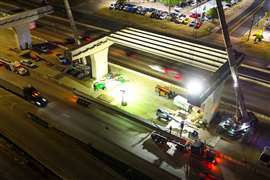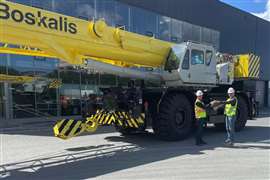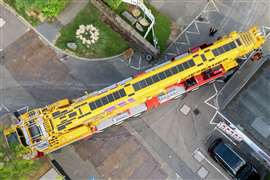Catching on
18 April 2008
Articulating crane manufacturers are increasingly optimistic about the long-term prospects for their products in North America. After a decade of dedicated efforts to obtain just a sliver of the American lifting pie, makers of articulating cranes, also known as knuckle boom cranes, are tasting success as customers have begun to see the material handling attributes of these highly engineered, easy-to-operate truck-mounted cranes.
Iowa Mold Tool builds among the most recognizable brand of knuckle boom cranes, mainly because their product line is built in the US in Garner, IA. Jim Darr, product specialist for material-handling systems at IMT, says that the major markets for IMT articulating cranes include “everything from wallboard companies to brick and concrete block companies, including utility companies, railroad construction, mining companies, equipmnt dealers, and anyone else who doesn't have large height requirements on the jobsite.”
Darr says IMT is steadily developing customer loyalty and has strong brand identification. “Our product line is definitely increasing in the North American market, and we mostly attribute this to our constantly improving product line as well as a growing acceptance of knuckle boom cranes in North America,” he says.
Darr says IMT off ers excellent product availability, a plus due to growing backlogs for boom trucks and similar capacity telescopic cranes. IMT and its competitors are continuing to introduce articulating cranes with longer reaches and greater capacities than ever before.
Fischer Crane Company based in Bolingbrook, IL, is a major player in the distribution of articulated truck cranes in the US, selling the Amco Veba line of articulated cranes, which are manufactured in Italy. Michael Fischer, president, says that his major markets include wholesale roofing and plumbing supply, as well as concrete form handling and cemetery monument installers. Other industries that regularly purchase knuckle boom cranes include precast concrete manufacturers and stone fabricators, including building stone and counter top suppliers, he says.
Fischer thinks that his company's growth is due to better acceptance of knuckle booms and also from being able to offer a quality product with strong customer support. “We see ongoing acceptance of the knuckle boom as the solution to a wide variety of material handling problems,” he says. “Years ago, many more prospects had to be educated as to the ability of knuckle booms to solve their material handling concerns. Most often now when a knuckle boom is offered, the client is familiar with the use of this equipment even if it is not their application.”
New designs and technologies have given articulating cranes an edge against competitors, as well, Fischer says. “T e development of hexagonal boom technology allows a greater number of boom extensions to provide clients with longer and longer reaches,” he explains. “This is the design element that all clients appreciate. With the additional extensions have come a variety of solutions to speed up the extension and retraction of the sections to improve work cycle times dramatically.”
Knuckle boom cranes are designed to lift in horizontal plane, which distinguishes their capabilities from telescopic cranes, Fischer says. “If a telescoping crane needs to hit the same spot with a significant load capacity it must be operated at an increased boom angle, necessitating a longer heavier boom,” he says.
Many of the newer models of knuckle boom cranes are “double jointed” and can bend a few degrees back on themselves, a nice option for placing loads through an opening, such as a window or doorway, where the second section of the boom can be raised 'backwards', by up to about 15 degrees, in relation to the first section.
Tim Arkilander, product manager for Finland-based Hiab Company, says the strongest markets for his company's product line include drywall, roofi ng, and concrete contractors. However, most Hiab cranes in North America are being used for the delivery and placement of materials used by home builders, he says.
Arkilander agrees that the market for knuckle boom cranes is increasing in the US, but noThat huge rates relative to other indicators, (as they relate to building materials). “Over the last 10 years the market has ranged from 1,600 to 2,200 units if you include drywall cranes, but not including forestry,” he says. “Hiab has grown, (doubled in four years) but that is [due to] a combination of capturing market growth and market share.”
Arkilander contends that Hiab cranes have a technological edge in the market, but for the most part, “the edge for articulating cranes over other methods is not coming from technology,” he says, “it is just concept selling – getting the word out.”
Safety attributes
The main obstacle in selling American customers on articulated cranes is competition, and that doesn't necessarily mean from other articulating crane brands. T ere are many different material handling solutions in the US, many that have been around longer and have greater acceptance than articulating cranes. But that is changing as these manufacturers persevere in North America.
Essentially, the primary competition for sales of knuckle boom cranes are boom trucks and piggyback forklifts, neither of which are very popular in Europe. Europe embraced the knuckle boom crane long before the US. Even though articulating cranes first showed up in the US in 1960, they were slow to catch on. T e good news for those marketing knuckle boom cranes in North America is that growth is expected to continue due to the health of the economy and the emergence of a variety of new markets, Darr says.
Changes in state and federal regulations related to operator certification are also helping stimulate sales of smaller articulating cranes. Stiffer laws are mandating operator training and/or certification for the operation of cranes with more than 25 feet of reach or more than 15,000 pounds of lift. Knuckle boom cranes are known to be operator friendly and safe, giving more customers reason to look again at their attributes.
Darr at IMT says: “Some of the attributes of IMT articulating cranes that have recently attracted customers include the safety overload systems such as the Rated Capacity Limitation (RCL) system, better and more dependable controls (i.e. fully proportional radio controls), better lift-to-weight ratios, and the fact that they have more reach, more capacity and the ability to haul more payload.”
Safety, technology and productivity are driving sales of knuckle boom cranes, according to Charles Letford, Crane Product Manager for Palfinger North America. “We are finding customers are interested in radio remote control options [available on articulating cranes.] Customers are also wanting a greater strength to weight ratio, and they are demanding higher output and with manual labor this is not possible.”
While articulating cranes most often do not have the reach capabilities that telescopic cranes have, they're typically used on job sites where vertical reach is not a major concern. However, new designs and technologies have significantly extended the capacities of articulating cranes. In the past, the rule of thumb was that if the reach requirement exceeded 25 feet, the task would be relegated to a telescopic crane. Not so today.
“People aren't aware that articulating cranes come with the reach they do today,” Darr says. “They're used to the idea that if they want something with an 80-foot reach, they're going to have to use a telescopic crane, and they don't realize that articulating cranes have that kind of reach these days.”
Suffice it to say that prospective customers of articulating cranes are hearing a lot about these machines, mainly due to the number of companies that are marketing them in North America. While there is room for growth in the market, the competition for the sale is intense, giving the buyer a great advantage – buying power.
STAY CONNECTED


Receive the information you need when you need it through our world-leading magazines, newsletters and daily briefings.
CONNECT WITH THE TEAM











